Morningstar - SFDR: il patrimonio dei fondi Art. 9 scende di 175 miliardi €
Oltre 300 fondi sono stati declassati ad Articolo 8 nel quarto trimestre 2022. In termini di asset, si tratta di 175 miliardi di euro, ovvero il 40% del patrimonio dei fondi dark green.
Morningstar, 27 Feb 2023 - 10:10
(English version below)
A quasi due anni dall'entrata in vigore del Regolamento sull'informativa sulla finanza sostenibile dell'Unione europea (SFDR) nel marzo 2021, il panorama dei fondi classificati come light green (Articolo 8) o dark green (Articolo 9) sta cambiando radicalmente.
Negli ultimi mesi, i gestori patrimoniali hanno lavorato per implementare gli standard tecnici di regolamentazione, o RTS, del Livello 2 della SFDR, che sono entrati in vigore nel gennaio 2023 e richiedono ai gestori di divulgare maggiori informazioni sugli approcci ESG dei loro fondi, sui rischi di sostenibilità e sull'impatto, all’interno dei documenti pre-contrattuali e nelle relazioni periodiche.
In vista di questo aggiornamento e del chiarimento normativo secondo cui i fondi che si dichiarano Articolo 9 possono avere solo in investimenti sostenibili, molti gestori hanno rivisto la classificazione dei loro fondi e declassato i prodotti dark green a light green.
Circa 420 prodotti hanno cambiato lo stato SFDR da settembre dello scorso anno, inclusi 307 che sono passati dall'Articolo 9 all'Articolo 8. In termini di asset, si tratta di 175 miliardi di euro, ovvero il 40% del patrimonio dei fondi Articolo 9. Ci aspettiamo che questi numeri aumentino nei prossimi mesi.
A seguito di questi declassamenti, la quota di fondi Articolo 9 sul totale del mercato dei fondi dell’Unione europea è scesa al 3,3% alla fine di dicembre, dal 5,2% di tre mesi prima, mentre la quota dei fondi articolo 8 è passata al 52,2%, dal 48,3%.
SFDR Fund Type Breakdown (by Assets)
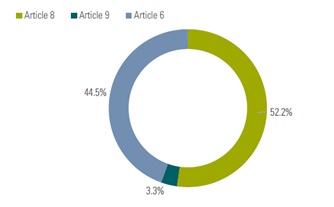
Source: Morningstar Direct. Assets as of Dec. 31, 2022. SFDR status as of Jan. 15, 2023, so January downgrades are accounted for. Based on SFDR data collected from prospectuses on 98.2% of funds available for sale in the EU, as well as January factsheets, KIIDs, PRIIP KIDs, and fund company websites, excluding money market funds, funds of funds, and feeder funds.as well as January factsheets, KIIDs, PRIIP KIDs, and fund company websites,
A seguito della riclassificazione di fondi indicizzati ed ETF (Exchange traded fund) che seguono i benchmark climatici dell'UE (benchmark allineati all’Accordi di Parigi e di transizione climatica), la quota di mercato dei fondi passivi Articolo 9 si è ridotta dal 24% al 5%.
SFDR Fund Type Breakdown (by Assets)
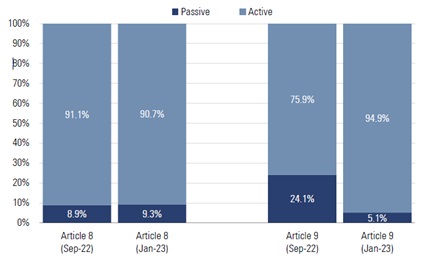
Source: Morningstar Direct. Assets as of Dec. 31, 2022. SFDR status as of Jan. 15, 2023, so January downgrades are accounted for. Based on SFDR data collected from prospectuses on 98.2% of funds available for sale in the EU, as well as January factsheets, KIIDs, PRIIP KIDs, and fund company websites, excluding money market funds, funds of funds, and feeder funds.as well as January factsheets, KIIDs, PRIIP KIDs, and fund company websites,
La minore rappresentazione dei fondi passivi nella categoria dell'Articolo 9 solleva interrogativi sulla fattibilità o sui meriti di un approccio di questo tipo per gli investitori che cercano un'esposizione pura agli investimenti sostenibili.
Tornano i flussi nei fondi Articolo 8, ai minimi quelli negli Articolo 9
Dopo tre trimestri di deflussi, i fondi Articolo 8 sono tornati in attivo, raccogliendo 10,7 miliardi di euro di nuovi capitali netti nell'ultimo trimestre del 2022. I fondi Articolo 9 hanno registrato gli afflussi più bassi di sempre, 5,1 miliardi, in parte a causa della recente ondata di declassamenti.
La raccolta positiva dei fondi Articolo 8 e 9 nel quarto trimestre contrasta con i 3,3 miliardi di deflussi registrati dai prodotti articolo 6 (i fondi tradizionali, Ndr), che hanno risentito maggiormente del contesto macroeconomico difficile, caratterizzato da pressioni inflazionistiche, rialzi dei tassi di interesse e persistenti timori di recessione.
Quarterly Flows Into Article 8 and Article 9 Funds Versus Article 6 Funds (EUR Billion)
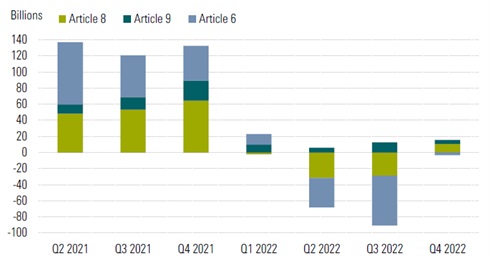
Source: Morningstar Direct. Data as of Dec. 31, 2022. Based on SFDR data collected from prospectuses on 98.2% of funds available for sale in the EU, excluding money market funds, funds of funds, and feeder funds.
La quota di mercato dei fondi Articolo 8 e 9 sale al 55%
Il patrimonio dei fondi Articolo 8 e 9 è aumentato del 7,3% nel quarto trimestre del 2022 a 4,6 trilioni alla fine di dicembre, trainato dai nuovi prodotti, dal passaggio di comparti dall'Articolo 6 all'Articolo 8 o 9 e, in misura minore, dall'apprezzamento del mercato. In confronto, gli asset dei fondi Articolo 6 sono diminuiti dell'1,1% nel periodo.
Di conseguenza, è aumentata la quota di mercato dei fondi Articolo 8 e 9 dal 53,5% di fine settembre al 55,5% di dicembre.
Quarterly Assets Into Article 8 and Article 9 Funds Versus Article 6 Funds (EUR Billion)
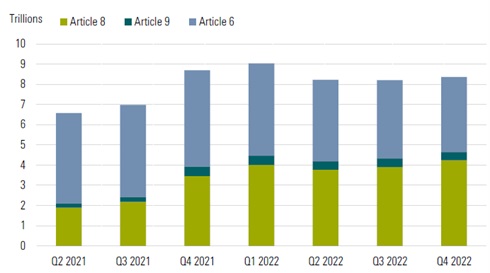
Source: Morningstar Direct. Assets as of Dec. 31, 2022. Based on SFDR data collected from prospectuses on 98.2% of funds available for sale in the EU, excluding money market funds, funds of funds, and feeder funds
Debutti: lo sviluppo rimane solido
Il lancio di nuovi prodotti è rimasto forte. Stimiamo che 165 fondi Articolo 8 e 49 fondi Articolo 9 abbiano debuttato negli ultimi tre mesi del 2022. È probabile che questo numero verrà rivisto al rialzo in futuro.
I nuovi fondi di cui all'Articolo 8 e all'Articolo 9 hanno rappresentato il 57% di tutti i lanci di nuovi fondi nell'UE.
Quarterly Number of Fund Launches
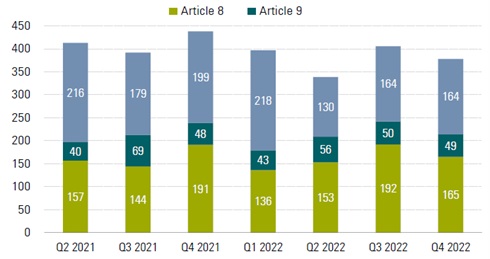
Source: Morningstar Direct. Data as of Sept. 30, 2022. Based on SFDR data collected from prospectuses on 97.4% of funds available for sale in the EU, excluding money market funds, funds of funds, and feeder funds.
I gestori hanno continuato ad ampliare la gamma di opzioni a disposizione degli investitori in termini di asset class, mercati, stili di investimento e temi. Mentre le offerte incentrate su ESG e sostenibilità in senso ampio hanno rappresentato la maggior parte dell'attività di sviluppo di nuovi prodotti, il clima si è confermato il tema più popolare tra i lanci di nuovi prodotti. Hanno debuttato più di 30 fondi climatici, che abbracciano diversi approcci di investimento. I fondi di questo tipo consentono agli investitori di ridurre il rischio climatico nei portafogli e/o ottenere un'esposizione a società che beneficeranno o contribuiranno alla transizione verso un'economia a basse emissioni di carbonio.
Tra gli altri temi incorporati dai nuovi fondi sostenibili ci sono una varietà di questioni ambientali e sociali, tra cui la biodiversità, gli ecosistemi, la sicurezza alimentare e l'assistenza sanitaria.
Per scaricare il report completo o per approfondimenti non esitate a contattarci.
Morningstar - SFDR: Article 9 fund assets shrink by EUR 175 billion (40%)
Almost two years after the European Union's SFDR came into force in March 2021, the landscape of funds classified as "light green" (Article 8) or "dark green" (Article 9) is going through some radical changes.
In recent months, asset managers have been preparing to implement the SFDR Level 2's regulatory technical standards, or RTS, which came into effect in January 2023 and require managers to disclose more information on their funds' ESG approaches, sustainability risks, and impact in precontractual documents and periodic reports.
Ahead of this upgraded disclosure regime and following a regulatory clarification that funds making Article 9 disclosures may only invest in sustainable investments, many managers reviewed their funds' classification and downgraded Article 9 products to Article 8.
About 420 products changed SFDR status since September last year, including 307 that downgraded to Article 8 from 9, representing EUR 175 billion in assets, or 40% of the Article 9 category. We expect these numbers to rise in the coming months as new prospectuses are processed.
As a result of these downgrades, the share of Article 9 funds in the overall EU fund market dropped to 3.3% at the end of December, from 5.2% three months earlier, while the market share of Article 8 funds jumped from to 52.2%, from 48.3%.
SFDR Fund Type Breakdown (by Assets)

Source: Morningstar Direct. Assets as of Dec. 31, 2022. SFDR status as of Jan. 15, 2023, so January downgrades are accounted for. Based on SFDR data collected from prospectuses on 98.2% of funds available for sale in the EU, as well as January factsheets, KIIDs, PRIIP KIDs, and fund company websites, excluding money market funds, funds of funds, and feeder funds.as well as January factsheets, KIIDs, PRIIP KIDs, and fund company websites,
Following the reclassification of sizable index funds and exchange-traded funds tracking EU Climate benchmarks (Paris-aligned and climate-transition benchmarks), the market share of Article 9 passive funds shrunk from 24% to 5%.
SFDR Fund Type Breakdown (by Assets)

Source: Morningstar Direct. Assets as of Dec. 31, 2022. SFDR status as of Jan. 15, 2023, so January downgrades are accounted for. Based on SFDR data collected from prospectuses on 98.2% of funds available for sale in the EU, as well as January factsheets, KIIDs, PRIIP KIDs, and fund company websites, excluding money market funds, funds of funds, and feeder funds.as well as January factsheets, KIIDs, PRIIP KIDs, and fund company websites,
The lower representation of passive funds in the Article 9 category raises questions about the feasibility or merits of an inexpensive rules-based approach for investors seeking pure exposure to sustainable investments.
Article 8 Fund Flows Back Into the Black; Article 9 Funds Register Lowest Inflows on Record
Meanwhile, following three quarters of outflows, Article 8 funds went back into the black, gathering EUR 10.7 billion of net new money in the final quarter of 2022. Article 9 funds pulled in the lowest inflows on record, EUR 5.1 billion, partly due to the recent wave of downgrades.
Positive inflows into Article 8 or 9 offerings in the fourth quarter contrast with the EUR 3.3 billion of outflows experienced by Article 6 products, which suffered more from the continuously challenging macro backdrop of inflationary pressures, interest-rate hikes, and lingering recession fears.
Quarterly Flows Into Article 8 and Article 9 Funds Versus Article 6 Funds (EUR Billion)

Source: Morningstar Direct. Data as of Dec. 31, 2022. Based on SFDR data collected from prospectuses on 98.2% of funds available for sale in the EU, excluding money market funds, funds of funds, and feeder funds.
Market Share of Article 8 and Article 9 funds rises to 55%
Assets in Article 8 and Article 9 funds rose by 7.3% over the fourth quarter of 2022 to EUR 4.6 trillion at the end of December, driven by newly launched funds, products that upgraded their SFDR status from Article 6 to Article 8 or 9, and to a lesser extent market appreciation. In comparison, Article 6 fund assets dropped by 1.1% over the period.
As a result, combined, Article 8 and Article 9 funds accounted for an increased share of the EU universe of 55.5%, from 53.5% three months earlier.
Quarterly Assets Into Article 8 and Article 9 Funds Versus Article 6 Funds (EUR Billion)

Source: Morningstar Direct. Assets as of Dec. 31, 2022. Based on SFDR data collected from prospectuses on 98.2% of funds available for sale in the EU, excluding money market funds, funds of funds, and feeder funds
Fund Launches: Product Development Remains Strong
Product development remained strong, with an estimated 165 Article 8 funds and 49 Article 9 funds launched over the last three months of 2022. It is likely this number will be restated upward in future reports as we identify more launches and additional ones are reported to Morningstar.
Newly incepted Article 8 and Article 9 funds made up 57% of all new EU fund launches.
Quarterly Number of Fund Launches

Source: Morningstar Direct. Data as of Sept. 30, 2022. Based on SFDR data collected from prospectuses on 97.4% of funds available for sale in the EU, excluding money market funds, funds of funds, and feeder funds.
Asset managers continued to expand the range of options available to investors in terms of asset class, market exposure, investment style, and theme. While general ESG- and sustainability-focused offerings continued to account for the largest part of the product development activity, climate remained the most popular theme represented among new product launches. More than 30 new funds with a climate flavor came to market, spanning all climate investment approaches. Climate-themed funds allow investors to reduce climate risk in portfolios and/or gain exposure to companies that will benefit from, or contribute to, the transition to a low-carbon economy.
Other new sustainable products target a variety of environmental and social issues including biodiversity, healthy ecosystem, food security, and healthcare.
To check out the our full report on SFDR or shall you need other information, do not hesitate to reach out to us.
It is the sole responsibility of the Sustainable Finance Partner to check the truthfulness, accuracy and completeness of the data and information entered on this web page, when within its competence and provided by the Partner. Borsa Italiana S.p.A. is not responsible for the contents developed by third parties and in particular by the Sustainable Finance Partners contained in this web page.
Glossario finanziario
Hai dei dubbi su qualche definizione? Consulta il glossario finanziario di Borsa Italiana.
